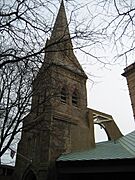First Church in Boston facts for kids
First Church in Boston is a special church with a long history. It's a Unitarian Universalist church today, but it started as a Congregationalist church. It was founded way back in 1630 by the first Puritans who settled in Boston, Massachusetts. These settlers were led by John Winthrop. The church building you see today is on 66 Marlborough Street in the Back Bay area. It was designed by Paul Rudolph after a fire in 1968. The new design kept parts of the older building from 1867. First Church has always been connected to Harvard University and Boston's famous Freedom Trail. The burial place of John Winthrop, who was Massachusetts' first Governor and a member of First Church, is on the Freedom Trail. He believed strongly in telling the truth and having religious freedom.
Contents
History of First Church
How the Church Began
The church community started in 1630. This was when the first settlers arrived on a ship called the Arbella in what is now Charlestown, Massachusetts. John Wilson was their first minister. He was the only minister while the church was in Charlestown. Two years later, the community built a meeting house across the Charles River in Boston, near where State Street is today. John Wilson officially became the minister there. In 1633, John Cotton came from England. He helped teach at the church and played a big part in setting up the Congregational Church. This was the official church of Massachusetts at the time.
Ministers and Changes Over Time
Pastors from the Massachusetts Bay Colony often visited and preached in other churches. First Church pastors would give guest sermons in other towns. For example, Governor Winthrop once walked twenty-five miles with his pastor to hear a sermon in Plymouth.
In 1677, a freed slave named Dorcas ye blackmore became the first African American to join the church.
In the 1700s, Charles Chauncy was a minister at First Church for sixty years. He was known for disagreeing with Jonathan Edwards during a time called the First Great Awakening. Chauncy thought Edwards's preaching was too emotional.
A Big Change for the Church
Around the early 1800s, the church went through a big change. It started as a Christian church that believed in the Trinity (God as Father, Son, and Holy Spirit). But by the mid-1800s, it became a Unitarian church. Many other churches in Massachusetts changed this way too. In 1833, the state churches in Massachusetts, including First Church, officially separated from the government.
In the 1800s, First Church moved to the Back Bay area of Boston. The building at 66 Marlborough Street was built in 1868. It was designed by architects William Robert Ware and Henry Van Brunt.
Merging Churches
Second Church, also known as the "Church of the Mathers," was founded in 1649. This happened as Boston grew, and people needed a church closer to their homes in the North End. From 1664 to 1741, important ministers like Increase Mather, Cotton Mather, and Samuel Mather served there. Both First Church and Second Church eventually moved from the busy downtown area to the newer, more fashionable Back Bay. This area was built on land that was filled in during the late 1800s and early 1900s.
After a terrible fire in 1968, First Church and Second Church decided to join together. They built a new church building at the 66 Marlborough Street location.
Architecture of the Building
The current church building uses parts of the old church that burned down in 1968. It includes the ruined front wall and the steeple tower made of "puddingstone" (a type of rock). After the fire, the church asked for new designs. The community chose the plan by Paul Rudolph, and the new building was finished in 1972.
Inside, the church is very bright and open. It has Rudolph's special "corduroy concrete" walls, which have a unique texture. Even decades later, the inside of the church looks very well cared for. People have been careful not to change the walls permanently and to keep the original fabric decorations looking new.
-
The burned rose window frame and front of the church
-
Steps outside that look like an amphitheater
Notable People Connected to First Church
Many important people have been part of First Church throughout its history:
- John Wilson (pastor from 1632–1667)
- John Cotton (pastor from 1633–1652)
- John Winthrop, who founded and was the first governor of Massachusetts Bay Colony
- Charles Chauncy (pastor from 1727–1787)
- William Emerson (pastor from 1799–1811)
- Arthur Foote (music director from 1878–1910)
- Stephen Kendrick (minister from 2001–present)
Images for kids
See also
- Second Church, Boston
- Oldest churches in the United States





















